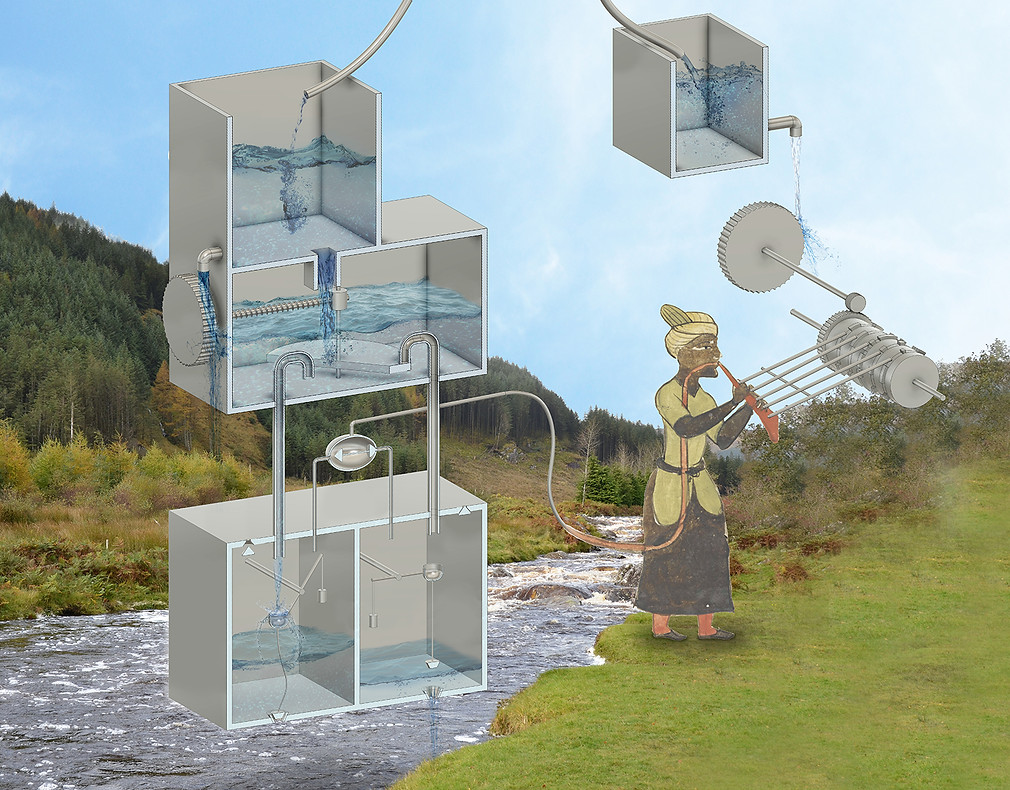1000 years ago

Invention of machines
Astrology-astronomy leads the sciences as Arabic and Chinese innovations in celestial navigation and map-making lead explorers across deserts and out into open ocean. Islamic scholars revive ancient knowledge of mechanics and machines powered by water, rather than muscles. In 850 the Persian Banu Musa brothers publish the Book of Ingenious Devices that details 100 inventions, including a water-driven system that fills and drains two vats in alternation, making a kind of engine that pumps air to play a flute in the hands of an automaton. (more)
Forests, population, and land under cultivation

Adapted from HYDE Historic Database of the Global Environment Land use map
Intact Forest
Cultivated land
= 1 million people
Measures

Global Population
8 billion in 2023
CO2 concentration
418 parts per million
in 2023
Average Temperature
15° C in 2023
Sea Level above level in 1900
24 cm in 2023
280 ppm
CO2
13.8°C
Temp.
275 million
Population
Sea level near datum
Medieval Warm Period c.950 - 1250
Black Death 1347-51
Little Ice Age 1300-1870
Years
Disease depopulates the Americas
Back to 10,000 years ago
Millennia
A millennium separates the philosophers of ancient Greece and Rome from the Islamic inventors who interpret their texts and spark mechanical innovations of all kinds. Their machines are entertainments for the king’s court, only much later adapted for practical use. For millennia, wood and animal oils are the only fuels. Forests have been regulated since ancient times with rules on cutting and hunting as strict as the feudal lords were strong. Large scale destruction or regrowth of forests has been correlated with the decline or success of empires.
At the scale of thousands of years, histories rely on archaeology to complement written records. Intimate details of individual sites and bones offer a window onto the rise and fall of civilizations, particularly when climate data is added to the narrative. Drought in particular can prove devastating for even large, well-established
societies such as Mayan Mexico about 800-1000 AD and Mediterranean cultures of Egypt, Greece and the Levant about 1250 to 1100 BCE. A global change in rainfall patterns starting about 2150 BCE affected ancient empires from Egypt to China. Archaeologists show that ancient cities did not succumb easily to climate stress, rather they learned and adapted, reshaping the land to retain water, and at times leaned on extensive trade networks for food. In the worst of times, when reservoirs ran dry and famine emptied cites, rigid, centrally-controlled empires could no longer hold power, and smaller societies emerged with innovative agricultural methods and rugged social organizations. The success of many ancient civilizations lay in increasingly complex practices of conserving water, soil nutrition, and old-growth forests, while farming the same land over thousands of years.
References
Text: Ibn Shakir, A. i. M. (1979). The book of ingenious devices (Kitab al-hiyal). Boston, D. Reidel Publisher.
Finkelstein, I. (2017). "Egyptian Imperial Economy in Canaan: Reaction to the Climate Crisis at the End of the Late Bronze Age." Agypten und Levante 27: 249-259.
David L. Lentz, N. P. D., Vernon L. Scarborough, Liwy Grazioso (2018). "Imperial resource management at the ancient Maya city of Tikal: A resilience model of systainability and collapse." Journal of Anthropological Archaeology 52: 113-122.
Middleton, G. D. (2018). "Bang or whimper? The evidence for collapse of human civilizations at the start of the recently defined Meghalayan Age is equivocal." Science 361(6408): 1204-1205.
Image: Composite of images: Flautist from Kitāb Arshimīdas fī al-binkāmāt كتاب أرشميدس في البنكامات Archimedes أرشميدس British Library Add MS 23391, ff 2r-21r. Diagram of flute machine constructed by Camila Lohzic based on Ibn Shakir, The book of ingenious devices
Map: Williams, M. (2006). Deforesting the earth: from prehistory to global crisis. Chicago, Chicago University Press.
Benjamin David Stocker, Zicheng Yu, Charly Massa and F. Joos (2017). "Holocene peatland and ice-core data constraints on the timing and magnitude of CO2 emissions from past land use." Proceedings of the National Academy of Sciences(201613889).
PBL Netherlands Environmental Assessment Agency. (2000). "HYDE: History Database of the Global Environment." Retrieved 22 September 2018, 2018, from http://themasites.pbl.nl/tridion/en/themasites/hyde/index.html.
Population Education. (2015, 26 March 2015). "World Population." Retrieved 21 September 2018, 2018, from https://www.youtube.com/watch?v=khFjdmp9sZk.
CO2: Etheridge, D. M., L. P. Steele, R. L. Langenfelds, R. J. Francey, J.-M. Barnola, V. I. Morgan. (1996. ). "Natural and anthropogenic changes in atmospheric CO2 over the last 1000 years from air in Antarctic ice and firn." Journal of Geophysical Research 101( D2 ): 4115-4128. https://doi.org/10.1029/95JD03410
British Antarctic Survey (2014) "Ice cores and climate change." British Antarctic Survey.
Etheridge, D. M., L. P. Steele, R. L. Langenfelds, R. J. Francey, J.-M. Barnola, V. I. Morgan. (1996. )
Temperature: NOAA National Centers for Environmental Information. (2016). "Climate Model Simulations of the Last 1,000 Years." Retrieved 20 September, 2018, from https://www.ncdc.noaa.gov/global-warming/last-1000-years
Sea Level: Robert E. Kopp, A. C. K., et al. (2016). "Temperature-driven global sea-level variability
in the Common Era." Proc Natl Acad Sci USA 113(11): E1434 - E1441.https://doi.org/10.1073/pnas.1517056113
Population: Wikipedia. (2018). "World Population Estimates." Retrieved 20 September, 2018, from https://en.wikipedia.org/wiki/World_population_estimates#Before_1950